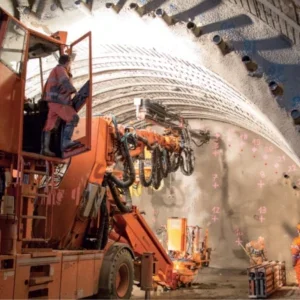Some years ago a paper titled “10 years of steel fibre concrete a manufacturers view” told the story of what had occurred in the UK market where fibres had actually been used in applications such as industrial flooring, external pavements and of course some tunnel works. Now, after almost 20 years, there much more to tell; a lot has happened regarding the use of fibres in the tunnelling industry not just in the UK but globally—more research, new guidance documents, the advent of the European standards for fibres and the relevant testing criteria, evolving performance based specifications, CE markings and of course, and more importantly, many more projects providing much more experience.
Main UK project experience
In the UK the first steel fibre segmentally lined tunnel was the 1.4km baggage tunnel at London Heathrow International Airport in 1995. This was a design and build project by Miller Tunnelling, now Morgan Sindall, in which the traditional reinforcement cage was completely removed and Dramix steel fibres used. By using the additional load bearing capacity that the high aspect ratio steel fibres give to the concrete, the lining thickness was reduced from the standard by 25 per cent, thus reducing the volume of concrete required and reducing the load being brought onto the lining.
Further projects followed as the industry wanted to understand the concept, and a section of the Jubilee Line Extension was built using steel fibre concrete segments manufactured by Charcon Tunnels, now Tarmac Building Products. The 1.2km twin line ran from London Bridge Station to Southwark station. Costain Taylor Woodrow was able to report that the damage to the segments was surprisingly very low when inspected—also they made use of Dramix steel fibres for the first time in the sprayed concrete works but then all in the temporary linings.
One of the most prestigious projects to be undertaken in London was the refurbishment of the East London Line’s Brunel Tunnel. The tunnel was originally completed in 1843 and had had very little done to it in terms of real maintenance over the years. By the early 1990s it was beginning to show its age and had some leakage that would only get worse in time. It was decided to refurbish both running tunnels entirely.
One of the main concerns was the potential of train derailing and impacting the new tunnel lining, so it was decided that a lining incorporating steel fibres with traditional reinforcement would be the appropriate solution. The lining would also benefit from resistance to potential thermal cracking and while maintaining a very small crack width, would provide excellent impact resistance; long term durability was considered and a corrosion resistant steel fibre was used in this case.
The fibre concrete was produced on site and pumped into the specially made shutters provided by Taylor Woodrow’s production facility in West London.
Many projects followed in the 1990s, mainly in the utility sector, and into the new millennium with two major projects— the tunnelling works for the new Heathrow Terminal 5 (T5 HEX) and the Channel Tunnel Rail part 2 (CTRL). Both projects used steel fibre concrete throughout the majority of the works – both in sprayed concrete and the precast segmental lining for the running tunnels. It should be noted that these tunnels had larger diameters than most of the previous projects in London, >5m id for the T5 HEX Extension and 7.15m id of the CTRL running tunnels. However at T5 Morgan Sindall used a sprayed concrete lining method called Lasershell for the first time; the use of ribs and support arches were eliminated and a high strength concrete lining was sprayed containing high carbon Dramix steel fibres with a tensile strength of >2,400mpa that provided a high degree of ductility where normal low carbon fibres would not cope with these high concrete strengths.
For these projects a significant development took place that provided tunnel linings with the resistance to explosive spalling due to fire. After the first fire event in the Channel Tunnel a major test programme was undertaken by Shuttleworth of RLE for the CTRL project. It clearly demonstrated the benefits of using micro polypropylene fibres-monofilament in concrete to minimize the explosive spalling and this work has since benefited tunnelling worldwide.
In this respect there have been some significant projects where steel fibres, usually with micro polypropylene fibres, have been used with and without traditional reinforcement cages and in some large diameter tunnels worldwide.
A major exercise was undertaken shortly after completion of the main CTRL tunnel works using Dramix RC-80/60-BN. It showed a remarkable lack of damage to the segments during manufacture, transportation and installation thus reducing repair time and costs significantly; these benefits are consistent throughout the tunnelling industry worldwide.
Based on this experience, the key requirements proposed for precast segments are mainly the following:
• Fibres should comply with the European Standard EN 14889-1
• Fibres with CE marking, system 1 (Fibres for structural use)
• Fibres of drawn wire, with a tensile strength of the steel wire F 1200 MPa
• Dimensional tolerances according to EN 14889-1
• Fibre length: 60 mm
• Aspect ratio l/d =80
• Glued fibres to ensure a good distribution and homogeneity in the concrete.
• Steel fibres must be added by way of an automatic dosing system
• Type of concrete: according to project requirement (C40 to C60)
In 2003 a design model from Rilem was published for testing and design of steel fibre concrete. Today the existence of national and international recommendations on the sizing of the structures or structural elements made up of these materials are perfectly validated for steel fibre concretes.
Furthermore, clear test methods are now available for the designer to determined the minimum dosage for each project: Min. average residual flexural strength is measured with standard EN 14651 “Test method for metallic fibered concrete – Measuring the flexural tensile strength (limit of proportionality [LOP], residual).
FR, 1 is the residual flexural tensile strength corresponding with CMOD =0.5mm, which is the key requirement for SLS design
Conclusion
I do believe the UK industry has gained a huge amount of steel fibre concrete experience over the last 15 years or so in tunnelling. I think that if one adds up the total number of reinforced lined tunnels with steel fibre concrete in the UK the distance covered will exceed 100km.
I firmly believe this will easily be more than doubled in the next 10 years Steel fibre concrete in tunnelling has been embraced in most countries around the world but it is only a matter of time before the use of steel fibres becomes almost the standard solution – not in all cases, but certainly in most.
The DLR is one of many UK projects to use steel fibre concrete. Image courtesy of Morgan Sindall Steel fibre concrete has been used in CTRL’s running tunnels. Image courtesy of HS1 CTRL has steel fibre concrete in both sprayed concrete and the precast segmental lining for the running tunnels. Images courtesy of HS1






